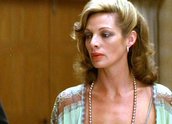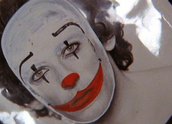


Harlequin (1980)
Synopsis
Mysterious drifter Gregory Wolfe (Robert Powell) appears dressed as a clown at the birthday party of Timothy (Mark Spain), the terminally ill son of Senator Nick Rast (David Hemmings) and his distant wife, Sandra (Carmen Duncan). Wolfe cures the boy and is invited to live at the Rast’s home, where he becomes close to Sandra and Timothy. Political kingmaker Doc Wheelan (Broderick Crawford) is grooming Nick to become Deputy Governor and is suspicious of Wolfe, who has become a celebrity among the city’s high society. Wrongfully arrested for an attack on the Rast’s maid, Alice (Alyson Best), Wolfe escapes custody and returns to the Rast mansion.
Curator’s notes
Harlequin is the most ‘internationalised’ of the genre movies produced in the 1970s and 80s by the prolific Antony I Ginnane. Like its better-known (in Australia) stablemates Patrick (1978), Thirst (1979) and Turkey Shoot (1982), Harlequin featured imported stars and made no mention of Australian locations or institutions. This Ginnane entry went the furthest into ‘nowhereland’ by applying a quasi-American texture to the production. Nick and Doc Wheelan drive around in big black motorcade-style limousines, the red white and blue bunting of an American political rally adorns Nick’s house at a charity function, American telephone ringtones are heard and some of the local support cast are dubbed into American – the same fate everyone except Mel Gibson suffered when Mad Max (1979) was released in the US.
Made when the Australian film revival was less than a decade old and no major producers other than Ginnane were tailoring movies for the international market, Harlequin drew criticism for its lack of Australian character and performed only moderately at the local box-office, with the notable exception of Perth. Harlequin was the first major film made in the West Australian capital for over 20 years, and the mansion of local millionaire Alan Bond was used as the exterior for the Rast home. Australian critics and audiences may have been cool but the story overseas was very different. Harlequin won awards at the prestigious Sitges and Paris Fantasy Film Festivals, received theatrical release in the US and UK and was a sizeable hit in several Latin American territories.
Antony I Ginnane claims that relative to its budget (around AUD$1 million) Harlequin ‘is one of the more successful Australian films ever’. All the hoopla surrounding Harlequin overshadowed its many qualities as a mystery thriller. Notwithstanding a few strained twists and some time and place incongruities that probably only Australian audiences noticed, the fanciful plot isn’t half-bad: Rasputin in modern dress played out against a backdrop of political intrigue. The names match up with the Russian figures – Gregory Wolfe/Grigori Rasputin; Nick Rast/Tsar Nicholas II; Tsaritsa Alexandra/Sandra Rast; Alexei Romanov/Alex Rast. Scriptwriter Everett De Roche even throws in a Jesus angle with a Shroud of Turin-like image of Wolfe that appears on the Rast’s kitchen floor.
Smoothly directed in widescreen by Simon Wincer (Phar Lap, 1983; Free Willy, 1993), Harlequin is one of the more polished Australian films of its day and mounts solid suspense by keeping the mystery of Wolfe alive until the final frames. Is he real or a fraud? Has he seduced Sandra? Is he an innocent who’s been framed? Who is the real puppeteer pulling the strings on Nick’s career, Wolfe or Machiavellian operator Wheelan? Crucial to the film’s success is the precise lead performance of British actor Robert Powell (Jesus of Nazareth, 1977), whose high cheekbones and cold stare make Wolfe charismatic and dangerous in the same moment. David Hemmings and Carmen Duncan are convincing as the distant couple and, in a role with thematic connections to his Oscar-winning performance as Willie Stark in All the King’s Men (1949), American veteran Broderick Crawford adds plenty of colour as Wheelan, the cigar-chomping powerbroker. Smartly paced and never dull, Harlequin is a notch above the ordinary genre film.
Harlequin was released in Australian cinemas on 20 March 1980.
- Overview
- Curator’s notes
- Video 3 clips
- Principal credits
- Find a copy
- Make a comment
- Map
- Extras
- Add your review



